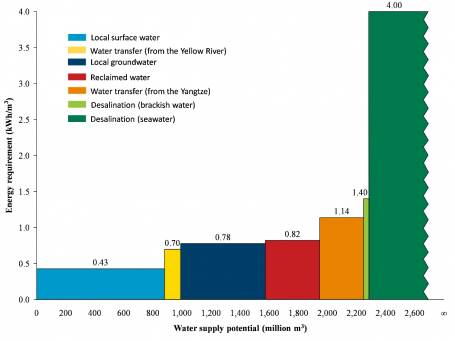Energy-gulping Desalination Can’t Solve China’s Water Crisis Alone

In fast-urbanizing China, nearly 90 percent of coastal cities face some degree of water scarcity and roughly 300 million rural residents lack access to clean water. To quench the country’s chronic thirst, the Chinese government has turned to desalination, aiming to produce as much as 3 million cubic meters of desalinated water daily by 2020, up from today’s 0.77 million cubic meter.
However, a WRI analysis shows that China’s desalination strategy would consume an enormous amount of energy, causing other problems such as increased greenhouse gas emissions and air pollution, and would cost more than most cities can afford.
Energy Costs of Desalination in Chinese Cities
The cities of Qingdao and Tianjin – where per capita water availability is only 12 percent and 7 percent of the national average, respectively – have both commissioned desalination plants. Qingdao’s desalination plant was constructed by the Spanish company, Abengoa, in 2010, and is said to produce 100,000 cubic meters of drinking water per day for 500,000 people (roughly 25 percent of Qingdao’s downtown population). Tianjin is home to the Beijiang and Dagang desalination plants, which together are expected to account for a third of China’s 1.5-2 million-ton capacity by 2015.
But desalination’s high-energy demand and steep capital expenditure and operational cost challenge it as a sustainable environmental and economic water supply approach. WRI conducted an analysis that looked at the different energy requirements for producing drinking water from various sources in Qingdao. On average, desalination plants consume 4 kilowatt-hours per cubic meter of freshwater produced, while wastewater reuse requires less than 1 kilowatt-hour of power to process the same volume and same quality of water. The price of energy accounts for as much as half of annual operating costs, making the cost of operation of desalination plants prone to price volatility in energy markets.
Figure 1 (see below) shows that desalination consumes roughly 10 times more energy than required to extract and process local surface water in Qingdao, largely owing to the energy intensive reverse osmosis (RO) process to remove the salts. WRI’s research indicates that reclaimed wastewater requires much less energy and expense compared to desalination and long-distance water transfers from the Yangtze River. In China, coal is the dominant energy source, accounting for approximately 79 percent of the total electricity produced in 2012. Therefore, consuming greater amounts of desalinated water would simultaneously increase greenhouse gas emissions. For example, if all 400,000 cubic meters of Qingdao’s proposed daily desalination capacity were in place, greenhouse gas emissions would increase by 80 percent per cubic meter of water produced.

Notes:
1. Water supply potential from various water sources are estimated based on Qingdao Water Resources Bulletin (Qingdao Water Resources Bureau, 2012) and Qingdao Desalination Development Plan (Qingdao Development and Reform Commission, 2005).
2. Energy requirements for unit water production from various water sources are estimated based on WRI’s field interviews and literature (such as Cohen et al., 2004; Singapore Public Utility Board, 2012).
Source: WRI, 2014
Desalination Should Not Be Prioritized as the Primary Water Source for a City
Some countries, such as the United Kingdom and Australia, have developed strategies to deal with the high cost and high energy demands of desalination technology. The United Kingdom, which opened its first large-scale desalination plant in 2010 with a capacity to supply water to up to 1 million people, only plans to supply desalinated water to the public in emergencies, such as droughts. During periods when it is not in use, it also doesn’t demand costly energy or emit greenhouse gases and air pollutants. Australia, on the other hand, has looked to renewable energy to power the desalination plant. For example, the Perth Seawater Desalination Plant reduces greenhouse gas emissions by utilizing electricity generated by a wind farm.
Until desalination technology becomes more energy efficient, it should only be used as a backup source of water in China. Continuous government investment in complementary technology, such as renewable energy sources, is also essential to reduce greenhouse gas emissions in desalination.
Most importantly, to help alleviate water stress in China, other, lower-cost, and more environmentally sustainable water sources – such as water efficiency investments and wastewater re-use – should be thoroughly investigated first and prioritized in China’s water resources planning.
LEARN MORE: Read our publication, Water Energy Nexusin the Urban Water Source Selection: A Case Study from Qingdao.